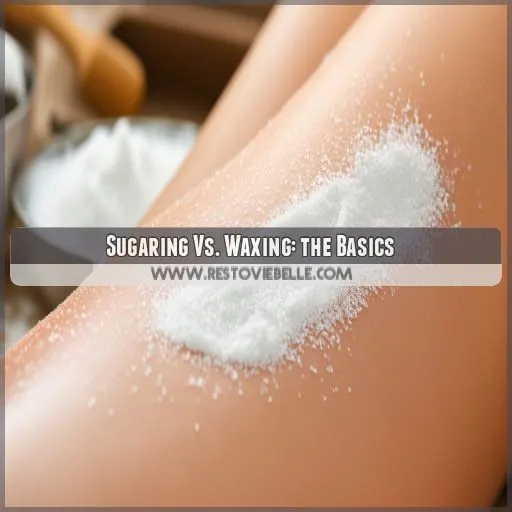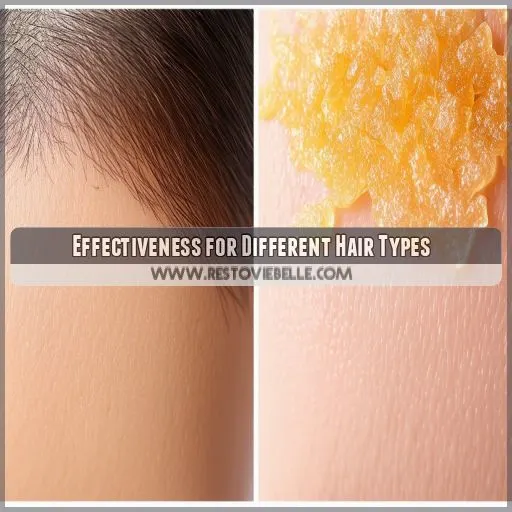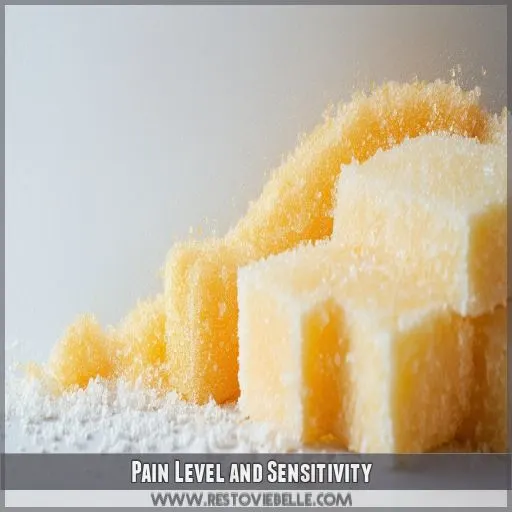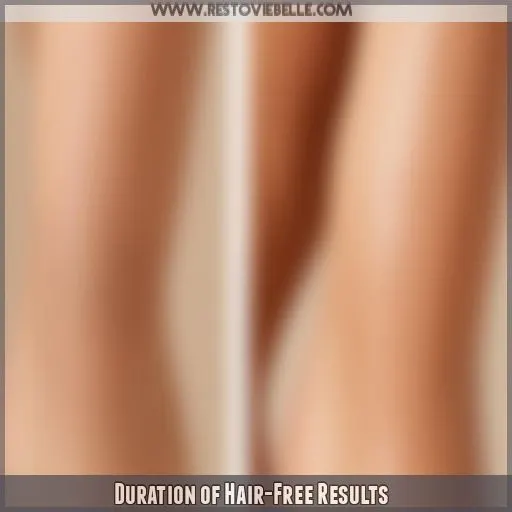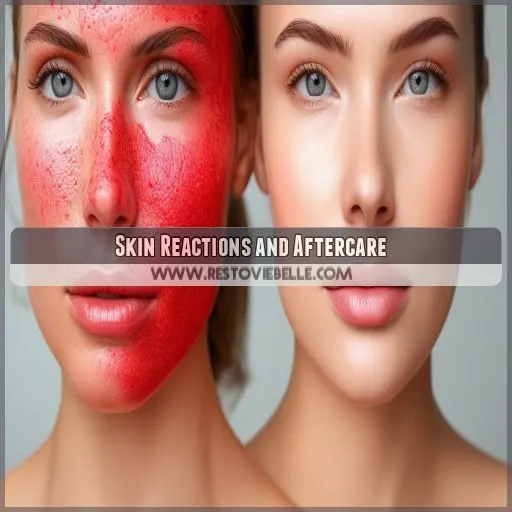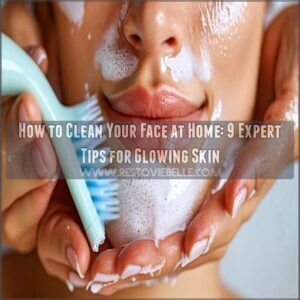This site is supported by our readers. We may earn a commission, at no cost to you, if you purchase through links.
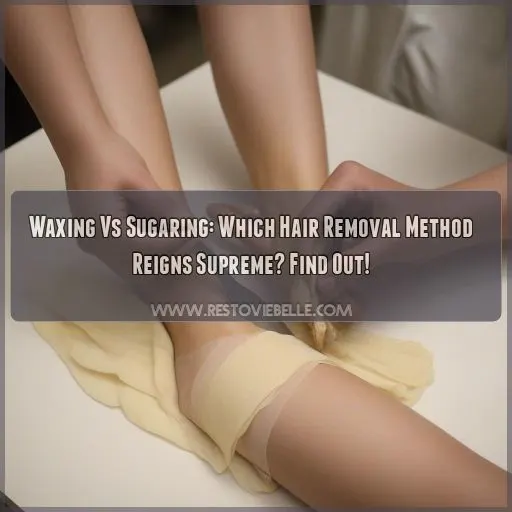 Tired of waxing pain and irritation? Maybe sugaring is your hair removal solution.
Tired of waxing pain and irritation? Maybe sugaring is your hair removal solution.
While both techniques are applied in a similarly painful way to yank the hair from its root, a key difference in application and removal brings a big difference onto the table of experiences.
Learn which method—waxing or sugaring—comes out on top for your special skin and hair type. Get ready to wave those unwanted fuzzies good-bye as you say hello to silky smooth and long-lasting results.
Table Of Contents
- Key Takeaways
- Sugaring Vs. Waxing: the Basics
- Effectiveness for Different Hair Types
- Pain Level and Sensitivity
- Duration of Hair-Free Results
- Skin Reactions and Aftercare
- Choosing the Right Method for You
- Frequently Asked Questions (FAQs)
- Is sugaring more effective than waxing?
- What is the downside to sugaring?
- Why does waxing hurt more than sugaring?
- How long does sugaring last?
- What is the cost difference between sugaring and waxing?
- Can sugaring or waxing be done during pregnancy?
- Are there any environmental benefits of sugaring over waxing?
- How often should I exfoliate before hair removal?
- What are the hygiene practices for salons offering these treatments?
- Conclusion
Key Takeaways
- Waxing and sugaring are hair removal methods with distinct approaches and outcomes.
- Sugaring is generally gentler and less painful, especially for sensitive skin and shorter hairs.
- Both methods offer long-lasting results, although sugaring may last slightly longer.
- Consider your skin sensitivity, hair type, and pain tolerance to choose the best method for your needs.
Sugaring Vs. Waxing: the Basics
You’ve probably heard about waxing and sugaring as popular hair removal methods, but what’s the real difference? Let’s break it down. Waxing involves applying a sticky mixture of beeswax, resin, and oils to your skin, while sugaring uses a natural paste made from sugar, lemon juice, and water. The application techniques differ too: waxing goes on with hair growth and is pulled off against it, while sugaring’s applied against growth and removed with it.
Cost-wise, sugaring tends to be pricier, but it’s often gentler on your skin and wallet in the long run. Availability? Waxing’s more common, but sugaring’s gaining ground. Environmentally, sugaring takes the cake with its biodegradable ingredients.
Both methods can cause some discomfort, but sugaring’s often less painful and may reduce your risk of ingrown hairs. Ultimately, your choice depends on your skin’s needs and personal preferences. Ready to dive deeper into which method might work best for you?
Effectiveness for Different Hair Types
Now that you’re familiar with the basics, let’s delve more deeply into what’s out there—exactly how waxing and sugaring compare with different types of hair. The most popular service for coarse hair is waxing. Its strong pull can really get that sometimes unruly hair, leaving you clean and smooth in all the right places. Sugaring, however, appears to be the most excellent solution in the gentle coaxing** of your hair out from the follicle without overworking and traumatizing your skin, which is already more sensitive in these delicate areas.
Longer hair? Both methods work totally fine for that, but waxing may very slightly be in the lead. On short hair though, sugaring really shines. It can grasp hairs as short as 1/16 of an inch while, say, waxing usually requires at least 1/4 inch to perform well.
Its ingredients and exfoliating nature make it a tender way of removing body hair for those with sensitive skin. Waxing is still not out of the game; it’s another powerhouse for body hair removal through waxing, especially on areas where the hair growth is dense and coarse.
Pain Level and Sensitivity
Now, when it comes to painfulness and sensitivity, you’ll find some striking differences between the two. Waxing is a lot more painful than its counterpart and may turn very excruciating in sensitive areas like the bikini area. The hot depilatory wax irritating the skin or turning it red is quite common, especially if you happen to possess extremely delicate skin. On the other hand, sugaring is generally gentler due to its natural ingredients. It’s less likely to cause skin reactions, making it a better choice for those with sensitive skin.
Take precautions against possible discomfort—for example, by avoiding caffeine before the appointment or taking a pain reliever if needed. Afterwards, it’s very important to take good care of your skin. Soothing creams or aloe vera reduce irritation. Special creams are recommended after waxing; with sugaring, simple remedies at home are enough.
Duration of Hair-Free Results
Now that pain levels are controlled, here’s making sense of how long you’ll be able to enjoy those silky smooth results. As for duration, waxing is pretty much equal to sugaring. Normally, with waxing, you’ll be able to enjoy that hair-free life for around 3-4 weeks, whereas if you choose to sugar, you may add an additional week of freedom. This difference in weeks can make a whole difference for your maintenance schedule.
With successive treatments, you’ll notice that the hair regrowth starts to become finer and less recurrent over time. You can always use hair minimizers or lotions between sessions for better hair-free times. Indeed, some people finally decide on laser hair removal after a number of waxing or sugaring treatments because of the long-term effects it offers.
Skin Reactions and Aftercare
After your hair-free results kick in, it’s time to talk about what happens next. Both waxing and sugaring can leave your skin feeling a bit sensitive, but don’t worry – it’s totally normal. You might experience some post-treatment redness, especially if you’ve got sensitive skin. It’s like your skin’s way of saying, "Hey, that was intense!"
To keep your skin happy and prevent ingrown hairs, you’ll need a solid aftercare routine. Courtney Claghorn, a hair removal expert, recommends avoiding sun exposure for at least 24 hours after treatment. Your skin’s more vulnerable, so slap on that sunscreen!
For those with thicker hair, you might be more prone to ingrowns. Exfoliate gently a few days after your treatment to keep those pesky hairs at bay. Remember, your skin’s just been through a lot, so treat it like royalty. Moisturize, hydrate, and give it some TLC!
Choosing the Right Method for You
When choosing between waxing and sugaring, consider your skin sensitivity, hair type, and pain tolerance. Understanding these factors will help you select the best method for your needs.
Skin Sensitivity Considerations
If you’re prone to skin irritation or damage, choose sugaring for its natural ingredients and gentle approach, which minimizes redness. For those with chemical sensitivity, sugaring uses simple ingredients like sugar, lemon, and water, reducing the risk of adverse reactions and promoting smooth, healthy skin.
Hair Type Assessment
While evaluating your hair type, look for these factors:
- Thickness: Waxing is better for thick hair, while sugaring performs well on fine hair.
- Allergic Reactions: Waxing may contain allergens; if you have overly sensitive skin, then go for sugaring.
- DIY Options: Sugaring can simply be prepared at home as a more affordable alternative and natural option.
Pain Tolerance Evaluation
Knowing your threshold for pain is also important in the decision between sugaring and waxing.
Waxing might be more painful because it’s removing your hair opposite to its growth—something known as "against the grain."
Sugaring is applied against and removed with growth, making the process less intense.
If you have a low threshold of pain, then choose sugaring for more effective management of that discomfort.
Frequently Asked Questions (FAQs)
Is sugaring more effective than waxing?
Sugaring can be more effective than waxing for those with sensitive skin and shorter hairs. It’s gentler, less painful, and avoids ingrown hairs. However, waxing is better for thicker hair and provides longer-lasting smoothness.
What is the downside to sugaring?
While sugaring may be gentler on your skin, it may not be as effective for thicker or coarser hair types. The results may also not last as long as waxing, requiring more frequent treatments.
Why does waxing hurt more than sugaring?
Waxing hurts more than sugaring because it adheres tightly to both the hair and skin, pulling skin and hair simultaneously during removal. Sugaring, applied against hair growth and removed with it, is gentler.
How long does sugaring last?
Imagine holding a delicate feather that floats away effortlessly. Sugaring, much like that feather, is gentle on your skin and its results can last up to five weeks, keeping your skin smooth and hair-free longer.
What is the cost difference between sugaring and waxing?
You can expect to pay around $10-$30 more for a sugaring session compared to waxing. The natural ingredients and gentler process make sugaring a bit pricier, but it’s often worth the extra cost for sensitive skin.
Can sugaring or waxing be done during pregnancy?
You can do both sugaring and waxing during pregnancy, but it’s advisable to consult your doctor first. Your skin might be more sensitive due to hormonal changes, making the experience more uncomfortable than usual.
Are there any environmental benefits of sugaring over waxing?
Sugaring uses natural, biodegradable ingredients like sugar, lemon, and water, making it more environmentally friendly compared to some waxing products that contain chemicals, non-biodegradable components, and require specialized cleansers.
How often should I exfoliate before hair removal?
Exfoliate 2-3 times a week to keep your skin smooth and radiant before hair removal. This prepares the area, allowing the wax or sugar paste to grip the hair effectively for a flawless result.
What are the hygiene practices for salons offering these treatments?
Ensure that your salon strictly maintains cleanliness by using disposable gloves, sterilizing tools after use, keeping the treatment area clean and tidy, offering sanitized towels and linens, and maintaining proper handwashing protocols for the staff.
Conclusion
Ultimately, one can literally say that it feels like a choice between the devil and the deep blue sea when one has to decide between waxing and sugaring. Both methods have very distinct benefits catering to your unique skin and hair type.
You should consider how high your pain threshold is, how sensitive your skin is, and what type of hair you have to make an educated decision.
Whichever road you choose to take, you’ll get smooth results that will last. Want to bid farewell to those unwanted fuzzies and feel the comfort of silky skin? Pick the right one and bid farewell to irritation.

